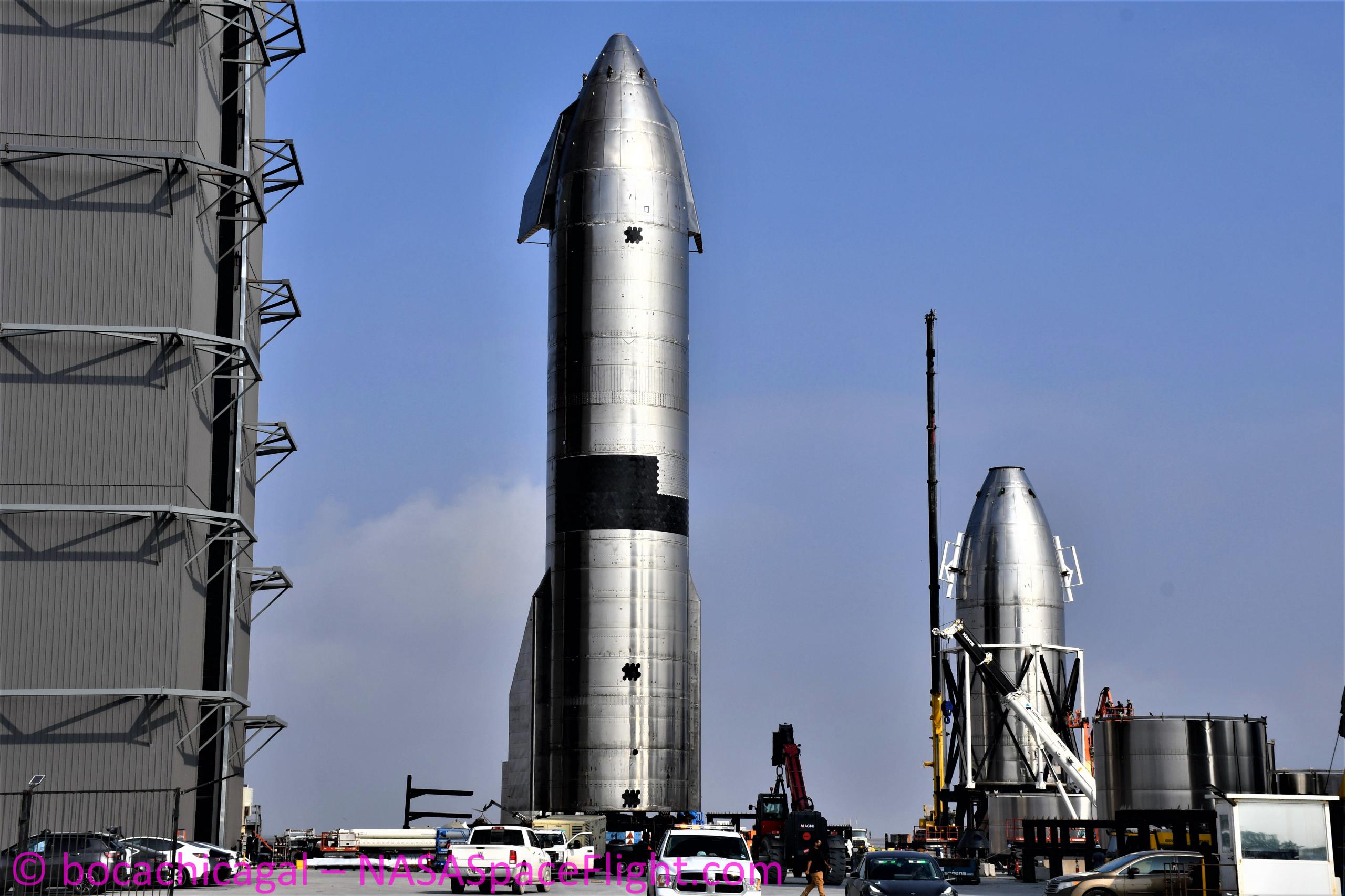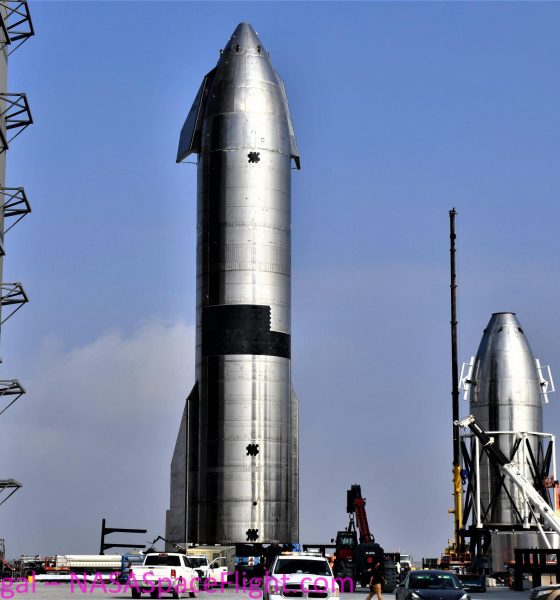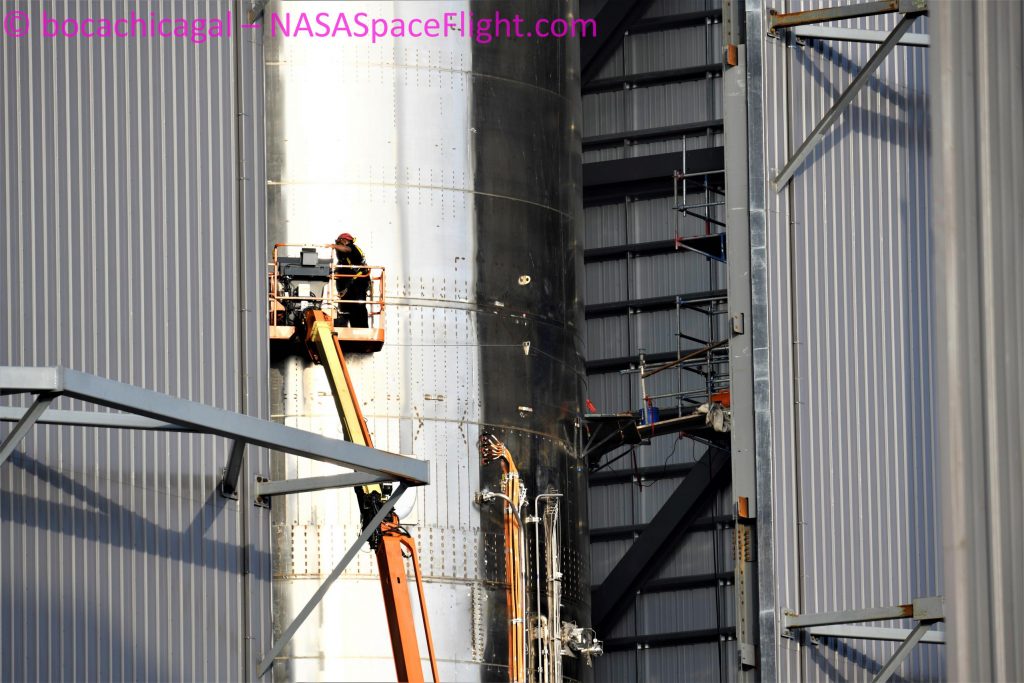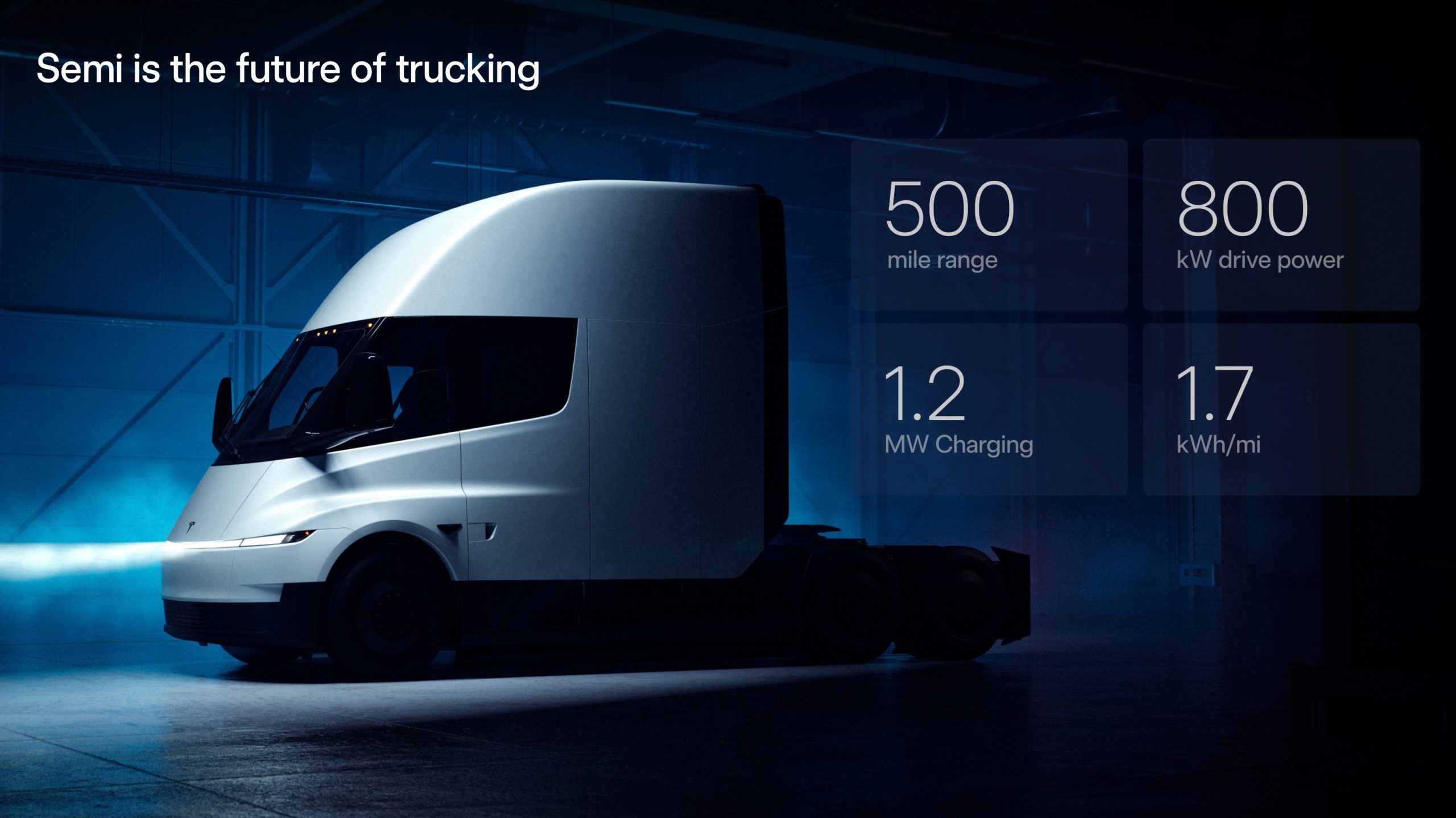

News
SpaceX rolls next Starship to the launch pad nine days after midair explosion
Update: Right on schedule, SpaceX has transported Starship serial number 15 (SN15) from its Boca Chica rocket factory to a launch and test site just down the road.
SN15’s pad arrival comes just nine days after Starship SN11 – the last in a batch of four first-generation prototypes – exploded in midair some 30 seconds before a planned landing. While minor, SN11’s midair failure was undoubtedly a step backward relative to Starship SN10, which (briefly) became the first full-size prototype to land in one piece less than a month prior. Both SN8, SN9, and SN10 made it further into their identical flight tests, leaving SN11 somewhat high and dry and putting extra pressure on Starship SN15.
After Starship SN8’s unexpectedly successful December 2020 test flight, in which the rocket made it just a dozen or so seconds away from soft landing after more than six minutes in flight, SpaceX made the decision to scrap Starship SN12 and kill SN13 and SN14 before assembly could begin. Effectively a gamble that SN8-SN11 would produce enough of a foundation for future testing to start off on, it’s hard to say if that gamble paid off.
All four Starship flights managed the extraordinary feat of more than four minutes of powered flight and spent two minutes free-falling like no rocket ever before them, but they also made it clear that both Raptor and autogenous pressurization (using gasified propellant to pressurize Starship’s tanks) are not quite mature enough for reliable launches and landings. Featuring “hundreds of improvements,” many of which were hopefully designed to tackle some of those shortcomings, it’ll be up to Starship SN15 to attempt to carry that torch forward – and, with any luck, further than any prototype before it.
After SpaceX unexpectedly used a Monday road closure to deliver its first custom-built rocket fuel tank, plans for the next Starship test campaign and launch have begun to solidify.
Most importantly, the initial schedule for Starship serial number 15’s (SN15) test campaign appears to be clear. As of Wednesday, April 7th, road closures filed by SpaceX suggest that the first of a new group of upgraded Starships will be transported from build site to launch pad as early as 11am-1:30pm CDT (UTC-5) on Thursday, April 8th. Once SN15 is installed on ‘Suborbital Pad A,’ SpaceX means to waste no time and has scheduled a 7am-12pm road closure on Friday.
As usual, the weekend will once again be free of any testing or activity requiring road closures, but SpaceX has already cordoned off noon to 8pm on Monday and Tuesday (April 12/13) to continue putting its newest Starship prototype to the test.

While road closure notices no longer offer any real detail, a few basic details can still be inferred. The April 7th closure, for example, warns that SpaceX only plans to intermittently close the highway but not Boca Chica Beach – implying that the window poses no threat to residents or beachgoers. Historically, that means that something will be transported – likely Starship SN15, in this case.
On Friday, SpaceX has scheduled a full five-hour closure of both the highway and beach, implying that some kind of testing is likely on the books. The same goes for Monday and Tuesday, but with longer eight-hour closures.
More likely than not, assuming Starship SN15’s pad transport and launch mount installation goes smoothly, SpaceX will use the shorter Friday window to complete a basic ambient pressure test – filling the rocket with ambient-temperature nitrogen gas to test its complex plumbing and propellant tanks for leaks. Continuing the IFF (if and only if) string, SpaceX will then spend the weekend preparing Starship SN15 for a cryogenic proof test and thrust structure stress test – simulating the thrust of three Raptors after loading the rocket with extremely cold liquid nitrogen (LN2).
SpaceX will then most likely spend another one or two days inspecting Starship SN15 and removing the hydraulic ram used to simulated thrust from the launch mount the ship is installed on. Once SN15 and its mount are cleared, SpaceX can move into static fire testing. Given that – according to CEO Elon Musk – SN15 will debut Raptor engines with an unknown degree of upgrades, it’s reasonable to assume that SpaceX will take things relatively slowly and possibly perform more than one static fire test even if the first attempt is a total success.
If not and SpaceX continues to push hard like it did with SN10 and SN11, it’s not out of the question that Starship SN15 will be ready for its first launch attempt around Friday, April 16th or Monday, April 19th. Stay tuned for updates as SpaceX hopefully rolls the rocket to its Boca Chica, Texas launch site later today.

News
Tesla Cybercab tests are going on overdrive with production-ready units
Tesla is ramping its real-world tests of the Cybercab, with multiple sightings of the vehicle being reported across social media this week.

Tesla is ramping its real-world tests of the Cybercab, with multiple sightings of the autonomous two-seater being reported across social media this week. Based on videos of the vehicle that have been shared online, it appears that Cybercab tests are underway across multiple states.
Recent Cybercab sightings
Reports of Cybercab tests have ramped this week, with a vehicle that looked like a production-ready prototype being spotted at Apple’s Visitor Center in California. The vehicle in this sighting was interesting as it was equipped with a steering wheel. The vehicle also featured some changes to the design of its brake lights.
The Cybercab was also filmed testing at the Fremont factory’s test track, which also seemed to involve a vehicle that looked production-ready. This also seemed to be the case for a Cybercab that was spotted in Austin, Texas, which happened to be undergoing real-world tests. Overall, these sightings suggest that Cybercab testing is fully underway, and the vehicle is really moving towards production.
Production design all but finalized?
Recently, a near-production-ready Cybercab was showcased at Tesla’s Santana Row showroom in San Jose. The vehicle was equipped with frameless windows, dual windshield wipers, powered butterfly door struts, an extended front splitter, an updated lightbar, new wheel covers, and a license plate bracket. Interior updates include redesigned dash/door panels, refined seats with center cupholders, updated carpet, and what appeared to be improved legroom.
There seems to be a pretty good chance that the Cybercab’s design has been all but finalized, at least considering Elon Musk’s comments at the 2025 Annual Shareholder Meeting. During the event, Musk confirmed that the vehicle will enter production around April 2026, and its production targets will be quite ambitious.
News
Tesla gets a win in Sweden as union withdraws potentially “illegal” blockade
As per recent reports, the Vision union’s planned anti-Tesla action might have been illegal.

Swedish union Vision has withdrawn its sympathy blockade against Tesla’s planned service center and showroom in Kalmar. As per recent reports, the Vision union’s planned anti-Tesla action might have been illegal.
Vision’s decision to pull the blockade
Vision announced the blockade in early December, stating that it was targeting the administrative handling of Tesla’s facility permits in Kalmar municipality. The sympathy measure was expected to start Monday, but was formally withdrawn via documents sent to the Mediation Institute and Kalmar Municipality last week.
As noted in a Daggers Arbete report, plans for the strike were ultimately pulled after employer group SKR highlighted potential illegality under the Public Employment Act. Vision stressed its continued backing for the Swedish labor model, though Deputy negotiation manager Oskar Pettersson explained that the Vision union and IF Metall made the decision to cancel the planned strike together.
“We will not continue to challenge the regulations,” Petterson said. “The objection was of a technical nature. We made the assessment together with IF Metall that we were not in a position to challenge the legal assessment of whether we could take this particular action against Tesla. Therefore, we chose to revoke the notice itself.”
The SKR’s warning
Petterson also stated that SKR’s technical objection to the Vision union’s planned anti-Tesla strike framed the protest as an unauthorized act. “It was a legal assessment of the situation. Both for us and for IF Metall, it is important to be clear that we stand for the Swedish model. But we should not continue to challenge the regulations and risk getting judgments that lead nowhere in the application of the regulations,” he said.
Vision ultimately canceled its planned blockade against Tesla on December 9. With Vision’s withdrawal, few obstacles remain for Tesla’s long-planned Kalmar site. A foreign electrical firm completed work this fall, and Tesla’s Careers page currently lists a full-time service manager position based there, signaling an imminent opening.
News
Tesla Semi program Director teases major improvements

Tesla Semi Program Director Dan Priestly teased the major improvements to the all-electric Class 8 truck on Thursday night, following the company’s decision to overhaul the design earlier this year.
Priestley said he drove the Semi on Thursday, and the improvements appear to be welcomed by one of the minds behind the project. “Our customers are going to love it,” he concluded.
Just drove the redesigned Semi. Our customers are going to love it. https://t.co/KZ88sf1CDL
— Dan Priestley (@danWpriestley) December 19, 2025
The small detail does not seem like much, but it is coming from someone who has been involved in the development of the truck from A to Z. Priestley has been involved in the Semi program since November 2015 and has slowly worked his way through the ranks, and currently stands as the Director of the program.
Tesla Semi undergoes major redesign as dedicated factory preps for deliveries
Tesla made some major changes to the Semi design as it announced at the 2025 Annual Shareholder Meeting that it changed the look and design to welcome improvements in efficiency.
Initially, Tesla adopted the blade-like light bar for the Semi, similar to the one that is present on the Model Y Premium and the Cybertruck.
Additionally, there are some slight aesthetic changes to help with efficiency, including a redesigned bumper with improved aero channels, a smaller wraparound windshield, and a smoother roofline for better aero performance.
All of these changes came as the company’s Semi Factory, which is located on Gigafactory Nevada’s property, was finishing up construction in preparation for initial production phases, as Tesla is planning to ramp up manufacturing next year. CEO Elon Musk has said the Semi has attracted “ridiculous demand.”
The Semi has already gathered many large companies that have signed up to buy units, including Frito-Lay and PepsiCo., which have been helping Tesla test the vehicle in a pilot program to test range, efficiency, and other important metrics that will be a major selling point.
Tesla will be the Semi’s first user, though, and the truck will help solve some of the company’s logistics needs in the coming years.








